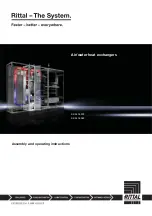
4 Installation
EN
10
Rittal air/water heat exchanger
4.3.3
Connecting the condensate discharge
A flexible condensate hose, dia. 12 mm (½"), can be fit-
ted to the air/water heat exchanger to drain any conden-
sate into a collecting bottle.
The condensate discharge
– must be laid with a suitable and constant gradient (no
siphoning),
– must be laid without kinks and
– must not have a reduced cross-section if extended.
The condensate hose (3301.612), condensate collect-
ing bottle (3301.600) and external condensate evapora-
tor (3301.500 or 3301.505) are available as accessories
(see also Accessories in the Rittal Catalogue).
Fig. 8:
Connecting the condensate discharge
Key
1
Connecting the condensate discharge
Connect a suitable hose to the condensate nozzle (at
the bottom of the door) and secure it with a hose clip
(with 2 Nm torque).
Lay the condensate hose, e.g. into a drain.
4.4
Connecting the water connection
The water hoses may optionally be connected to the top
or bottom of the device (¾" internal thread).
First, remove the sealing caps using an SW 22 open-
jawed spanner.
Fig. 9:
Removing the sealing caps at the top
Key
1
Water inlet, top
2
Open-jawed spanner
3
Water outlet, top
Fig. 10:
Removing the sealing caps at the bottom
Key
1
Water inlet, bottom
2
Water outlet, bottom
The cooling water hose
– must be laid without kinks
– must not have a reduced cross-section if extended
and
– if necessary, must be insulated.
Note:
The air/water heat exchanger may be fitted
on a base/plinth system (refer also to Acces-
sories in the Rittal Catalogue).
1
Warning!
Switch off the power supply to the air/
water heat exchanger before opening
the electrical connection box and before
working on the water circuit, and take
suitable precautions against it being ac-
cidentally switched on again.
Note:
The water inlet temperature should be select-
ed to prevent the formation of critical con-
densation in the enclosure being cooled.
1
2
3
1
2
Water outlet,
Water inlet,

























